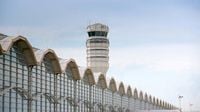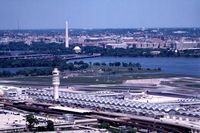Flights in and out of Reagan Washington National Airport, just outside the nation’s capital, ground to a sudden halt late Monday morning after a fire alarm blared through the air traffic control tower. The disruption, which began at 10:45 a.m. on August 18, 2025, forced the Federal Aviation Administration (FAA) to pause all air traffic, leaving passengers stranded and schedules in disarray. By midday, the tower was declared fully operational, and flights gradually resumed, but the ripple effects of the shutdown continued to be felt throughout the day.
According to the FAA, the fire alarm was activated in the air traffic control tower, prompting immediate action. “A fire alarm was activated in the air traffic control tower,” the agency said in a statement reported by AP and NBC Washington. The FAA did not specify whether an actual fire was found, but the mere sound of the alarm was enough to bring operations to a standstill. “The tower is back to being fully operational,” the FAA later confirmed to NewsNation, as cited by The Hill.
For nearly an hour and fifteen minutes, between 10:45 a.m. and noon, not a single commercial flight took off or landed at Reagan National. The impact was immediate and far-reaching. According to the flight tracking website FlightAware, a staggering 173 flights bound for the airport were delayed on Monday. Even after the all-clear, the backlog created a domino effect, with inbound flights experiencing average delays of 39 minutes as the airport worked to clear the congestion. The FAA attributed these ongoing delays to the sheer volume of flights trying to catch up after the unexpected pause.
Travelers caught in the disruption described scenes of confusion and frustration. Some watched as their departure times were pushed back repeatedly, while others waited anxiously for updates. Business travelers, families, and tourists alike faced the same uncertainty: when would their flights actually leave or arrive? For many, it was a stark reminder of how even a brief technical hiccup can upend the tightly choreographed world of modern air travel.
This incident comes at a time when aviation safety is already under intense scrutiny. Earlier this year, Reagan National was the site of a devastating tragedy: an American Airlines flight and an Army Black Hawk helicopter collided near the airport, resulting in the deaths of all 67 people aboard both aircraft. According to AP and The Hill, this was the deadliest plane crash in the United States since 2001. The memory of that disaster still lingers in the minds of airport staff and passengers, casting a long shadow over every new incident, no matter how minor it might appear at first glance. “That crash, combined with a series of other crashes and close calls since then, have stoked fears about the safety of air travel,” AP reported.
In the months following the January tragedy, a series of notable aviation incidents across the country have further raised questions about the safety of America’s skies. Near-misses, emergency landings, and technical malfunctions have all made headlines, fueling public anxiety and putting pressure on regulators and airlines to demonstrate that safety remains their top priority.
The FAA, for its part, has emphasized that it acted swiftly and appropriately in response to Monday’s fire alarm. “We paused flights heading to Reagan Washington National Airport due to a fire alarm in the air traffic control tower,” the agency explained in its initial statement, as reported by The Hill and NewsNation. Once it was clear that the tower could safely resume operations, the FAA began the painstaking process of restoring normal flight schedules. “We are slowing flights into Reagan Washington National airport due to volume after inbound flights were paused because a fire alarm was activated in the air traffic control tower,” the agency added, highlighting the logistical challenges involved in restarting such a complex operation.
Still, the incident has reignited debates about the resilience of the nation’s air traffic infrastructure. How prepared are airports like Reagan National to handle sudden emergencies, whether real or false alarms? Are there sufficient redundancies and contingency plans in place to minimize disruptions and keep passengers safe? These are not new questions, but each new event brings them back to the forefront.
For many in the Washington, D.C. area, Reagan National is more than just an airport—it is a vital link to the rest of the country and the world. Its proximity to the capital makes it a hub for lawmakers, diplomats, tourists, and business travelers. Any disruption here has outsized consequences, rippling across the region’s economy and affecting thousands of people in a matter of minutes.
Monday’s fire alarm was, in the end, a false alarm. The FAA confirmed there was no fire, and by midday, the control tower was back to full strength. But the episode serves as a powerful reminder of the delicate balance that keeps air travel running smoothly. Even a brief interruption can have major consequences, not just for schedules but for the public’s sense of security.
Aviation experts note that incidents like this, while disruptive, are also evidence that safety protocols are working as intended. The decision to halt all flights, even at the cost of significant delays, reflects a commitment to erring on the side of caution. “Safety always comes first,” one industry analyst commented, echoing the sentiments of both regulators and airlines.
Yet, for those who rely on Reagan National every day, the hope is that such disruptions remain rare. The memory of January’s tragedy is still fresh, and every new scare, no matter how brief or benign, is a reminder of the stakes involved. As one traveler waiting in the terminal put it, “It’s frustrating to be delayed, but I’d rather be safe than sorry.”
Looking ahead, the FAA and airport officials will likely review Monday’s incident to see what lessons can be learned. Was the response fast enough? Were passengers kept adequately informed? Could anything have been done to minimize the impact on flight schedules? These are the questions that will shape future responses and, hopefully, make the system even more resilient.
For now, flights are moving again at Reagan National. The control tower stands watch over the runways, and the steady hum of takeoffs and landings has returned. But for everyone who was there on Monday, the memory of that sudden, unexpected silence will linger—a reminder that, in aviation, vigilance is always the order of the day.



